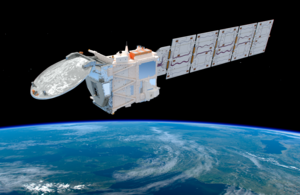EarthCARE (Earth Clouds, Aerosols and Radiation Explorer) is a joint European-Japanese mission, due for launch in May 2024, with significant UK involvement.
The mission should lead to more reliable climate predictions and better weather forecasts.
EarthCARE is being developed by the European Space Agency in co-operation with JAXA, the Japanese Aerospace Exploration Agency, and will address the need for a better understanding of the interactions between cloud, radiative and aerosol (fine particles) processes that play a role in climate regulation.
The EarthCARE satellite is the sixth Earth Explorer mission of ESA’s Living Planet Programme. Earth Explorers are focused research missions dedicated to specific aspects of our planet’s environment carrying onboard leading-edge technologies, with the overall emphasis on learning more about the interactions between components and the impact that human activity is having on natural processes.
Aerosols control cloud properties, while clouds control the production of rain and convection influences stratospheric humidity. The observations of EarthCARE will lead to more reliable climate predictions and better weather forecasts.
Mission facts
On 27 May 2008, the European Space Agency and Astrium GmbH signed a contract worth €263 million to provide the EarthCARE satellite with Astrium GmbH responsible for the satellite’s design, development and integration.
EarthCARE has been designed with the specific scientific objectives of measuring cloud-aerosol-radiation interactions so they may be included in climate and numerical weather forecasting models.
The satellite will launch on a Falcon 9 rocket from Vanderburg Air Base in the USA.
Technology
Illustration of EarthCARE gathering data. Credit: ESA/ATG Medialab
EarthCARE will employ high-performance lidar and radar technology that has never been flown in space before, with the objective to deliver unprecedented datasets to allow scientists to study the relationship of clouds, aerosols and radiation at accuracy levels that will significantly improve our understanding of these highly variable parameters.
The satellite will weigh about 1.7 tonnes and will carry 4 instruments: an Atmospheric Lidar, a Broad-Band Radiometer and a Multi-Spectral Imager developed by ESA, and a Cloud Profiling Radar developed by JAXA.
ATLID (Atmospheric Lidar) and CPR (Cloud Profiling Radar) will provide vertical profiles of cloud and aerosol structures.
The multi-spectral imager (MSI) will enable different cloud types and aerosols to be distinguished and will provide the meteorological/optical framework of the actively sampled profiles.
The Broad-Band radiometer (BBR) will provide broadband radiances at the top of the atmosphere that will serve as a consistency test of the retrievals of cloud radiative properties from the active instruments.
UK involvement
Airbus Defense & Space UK was responsible for the full satellite base platform as part of the core team.
Surrey Satellite Technology (SSTL) is supplying the MSI instrument which includes a VNS camera (covering the visible, near-infrared and shot-wave infrared bands of the electromagnetic spectrum) as well as a camera covering the thermal infrared band.
The MSI Instrument Control Unit is located within the interior of the satellite and is being developed by Thales Alenia Space UK (TAS UK).
TAS UK will also supply the Broadband Radiometer instrument, while RAL Space supplied the Broadband Radiometer Telescope Assembly. Teledyne e2V were responsible for the detectors on the ATLID instrument.
GMV-UK, Telespazio UK & CGI UK are all involved in ground segment activities, while CGI produced onboard software for the ATLID, MSI and BBR instruments.
After launch, a number of UK universities are anticipated to be involved within the validation of the data produced from EarthCARE.
Learn more about EarthCARE from ESA.


